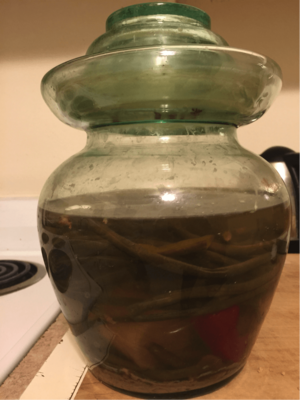Chinese pickles facts for kids
Chinese pickles are tasty vegetables and fruits that have been preserved. They are made by pickling them with salt or by marinating them in special sauces. These sauces often use soy sauce or savory bean pastes. Some pickles are made from crunchy veggies like Chinese cabbage and carrot. Others use fruits like apple and pineapple. There are also many kinds made from cucumbers, winter melon, and radishes. Did you know there are over 130 different kinds of Chinese pickles?
Contents
A Long History of Chinese Pickles
Chinese pickles have a very long history. They were first made around 1100 B.C.E. during the Zhou dynasty. The Chinese word for "pickle" means "salt and incubate." People started pickling food to keep it fresh for a long time. This was super important before refrigerators existed! Farmers would pickle extra vegetables and fruits after harvest. This way, they had food to eat all year round.
The Delicious Flavors of Pickles
Chinese pickles are known for their balanced flavors. They often mix sweet, sour, salty, bitter, and savory tastes. Some pickles can also be spicy, like those with Szechuan pepper. Most Chinese pickles aim for a mix of vinegar, salt, garlic, ginger, soy sauce, hot chili, and sugar. The taste of the vegetable or fruit itself is also important.
Most pickles need to sit for a few months to get their full flavor. This process is called fermentation. But there are also "quick pickles" that you can eat much sooner. Some cucumber pickles, for example, are ready in just a few hours!
How People Enjoy Chinese Pickles
Chinese pickles can be eaten in many ways. You can eat them straight from the jar as a small snack. They are also used as an ingredient when cooking bigger dishes. Before a meal, pickles are often served with drinks like tea or soda. This helps to get people's appetites ready for the main food. People also enjoy small dishes of pickles while they chat.
Pickles can be a simple side dish with steamed rice when there aren't many other foods. They are also great for adding flavor to meals. Pickled ginger and pickled pepper are often used in Sichuan food. Pickles can make vegetable, meat, poultry, and seafood dishes taste even better. For example, some people cook duck soup with pickled radish to make it extra delicious.
Fermented Pickles
Many Chinese pickles are made by fermenting vegetables and plums. This means they are salted and left to change with the help of tiny lactic acid bacteria. Sometimes, Chinese wine and spices are added during this process. Some types of these preserved vegetables are even dried multiple times after they ferment.
Here are some examples of fermented Chinese pickles:
- Gongcai (simplified Chinese: 贡菜; traditional Chinese: 貢菜; pinyin: gòngcài)
- Meigan cai (Chinese: 梅菜; pinyin: méi cài)
- Suan cai (Chinese: 酸菜; pinyin: suāncài)
- Tianjin preserved vegetable (Chinese: 冬菜; pinyin: dōngcài)
- Prunus mume (Chinese: 酸梅; pinyin: suān méi)
- Zhacai (Chinese: 榨菜; pinyin: zhàcài)
- Ya cai (Chinese: 芽菜; pinyin: yácài)
- Changzhou dried turnip (Chinese: 常州萝卜干; pinyin: Chángzhōu luóbo gān)
Marinated Pickles
Other Chinese pickles are made by marinating vegetables. This usually means soaking them in a mixture of soy sauce, sugar, vinegar, salt, and other spices. The vegetables are often lightly boiled in this sauce first. Then, they are left to cool and soak up all the yummy flavors.
Here are some examples of marinated Chinese pickles:
- Pao cai (Chinese: 泡菜; pinyin: pàocài)
- Cucumbers (simplified Chinese: 酱瓜; traditional Chinese: 醬瓜; pinyin: jiàng guā)
- Radishes (simplified Chinese: 腌萝卜; traditional Chinese: 醃蘿蔔; pinyin: yān luóbo)
- Bitter melon (simplified Chinese: 腌苦瓜; traditional Chinese: 醃苦瓜; pinyin: yān kǔguā)
- Garlic (simplified Chinese: 腊八蒜; traditional Chinese: 臘八蒜; pinyin: làbā suàn)
See also
 In Spanish: Encurtido chino para niños
In Spanish: Encurtido chino para niños


